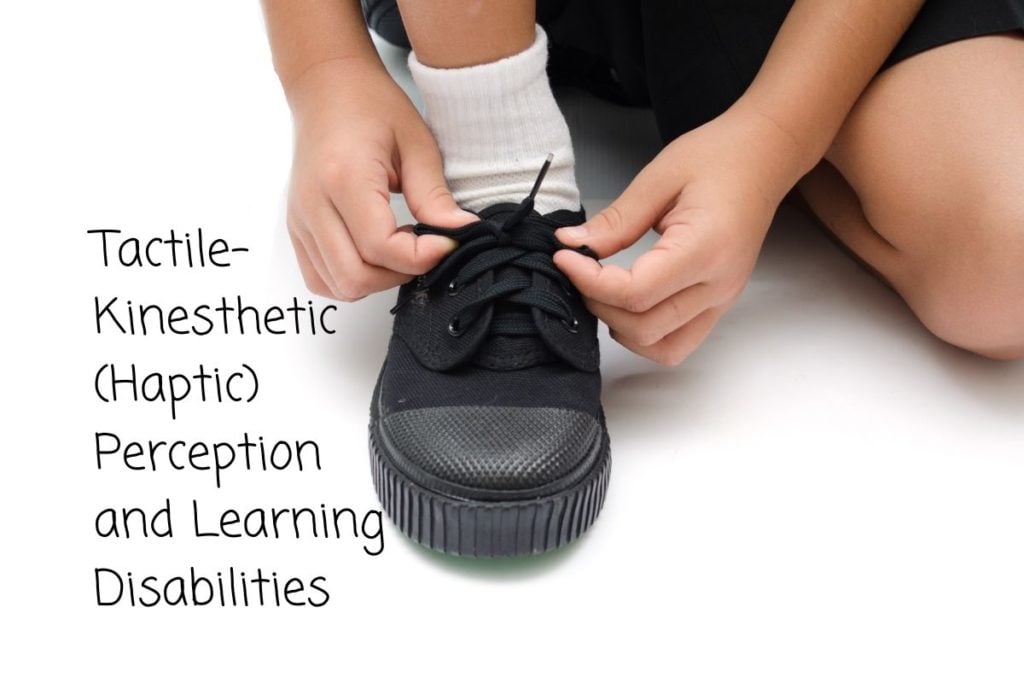
Tactile and kinesthetic perceptions usually go hand in hand; together, they are called haptic. Tactile perception refers to the sense of touch, while kinesthetic perception deals with the sense of body movements and muscle feelings.
They provide information about object qualities, bodily movements, and their interrelationships. They thus constitute the basic rubric of perceptual-motor learning.
Chalfant and Scheffelin observed that the child having problems in haptic processing has difficulties dealing with information, on the one hand, relating to geometry, texture, pressure, pain, or temperature, and, on the other, about the body itself when in motion or static position. In general, the problems noted in the learning disabled in the area of haptic perception fall into the following components:
- .Tactile discrimination refers to the ability to feel the differences between objects. The child with difficulty in this area cannot recognize object differences through touch alone. Thus, differences in texture, temperature, and shapes of hidden objects elude the child.
- Body image refers to the awareness of one’s own body and the relation of body parts to each other. The child who has a problem in this area lacks awareness of body parts in relation to each other and is unable to identify them. Finger agnosia, an inability to tell fingers apart or touch when blindfolded, is a frequently mentioned problem.
- Perceptual-motor integration refers to the ability to coordinate motor movement with visual or auditory stimuli. The child with difficulty in this area has problems coordinating what they see or hear with an appropriate motor response required in fine motor skills, for example, in copying or writing to dictation, or in gross motor as kicking a football or shooting a ball into a basket. Kephart described the ability to collate the two types of information, perceptual and motor, as making a “perceptual-motor match,” while Frostig referred to it as “eye-hand coordination.”
- Motor learning refers to the ability to perform routine motor acts. The child with a manifest difficulty in this area cannot perform everyday tasks requiring motor movements such as dressing, undressing, tying shoelaces, etc., or more skilled acts like skipping, riding a bike, catching or throwing, hitting a ball with a bat, etc. Referred to as nonverbal or motor apraxia, the child essentially has coordination and balance problems in gross and fine motor movements.
- Spatial orientation refers to the ability to perceive one’s physical self in relation to objects in the environment. The child’s distorted judgment of their own position in space and lack of body balance causes them to appear clumsy and uncertain about directions and distances. In other words, the learning disabled bumps into things, cannot estimate distances, and consequently over- or under-reaches and frequently lose their way when going to a destination no matter how familiar the route.
- Laterality and directionality. Laterality refers to motor awareness of the two sides of the body, while directionality refers to the ability to know right from left, up from down, forward from backward, etc. The child who has difficulties in this area is unable to internalize the knowledge that the body has two sides and, as a consequence, has difficulty dealing with directions of objects in relation to self, such as “to my right,” “to my left,” “above me,” “below me, ” “near me,” “far from me,” etc. Such a child has difficulty following directions on paper-pencil tasks such as “write your name in the top right-hand corner,” “draw a line under the word __________,” and the like.
Another manifestation frequently noted is a mid-line crossing problem; that is, the child is unable to continue a motor act like writing without switching hands at the point which faces their middle. To illustrate, the left-hander writes up to the middle of the page and changes hands or moves to the next line leaving the right half blank, while the right-hander writes from the middle leaving the left half blank.
Characteristically, then, the learning disabled is often clumsy with an uneven gait and poor balance, performs poorly in gross and fine motor tasks, shows discomfort when touched, stands too close or too far when communicating with others, and has a distorted body concept.
Edublox offers cognitive training and live online tutoring to students with dyslexia, dysgraphia, dyscalculia, and other learning disabilities. Our students are in the United States, Canada, Australia, and elsewhere. Book a free consultation to discuss your child’s learning needs.

